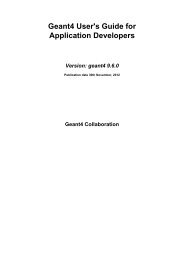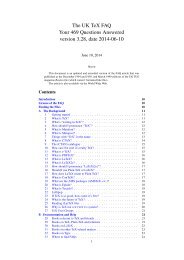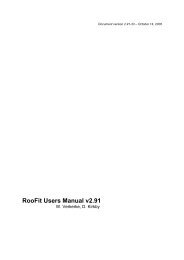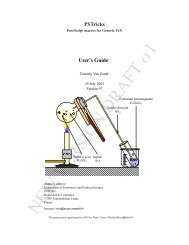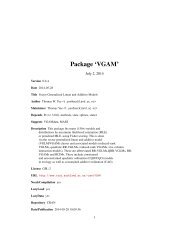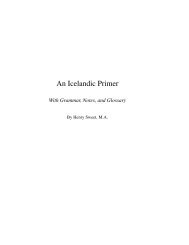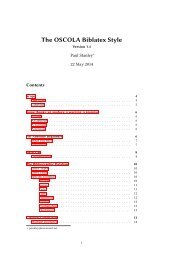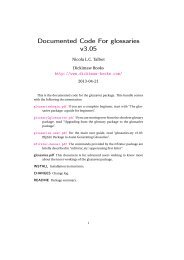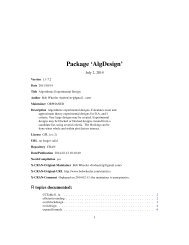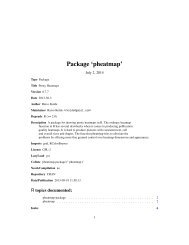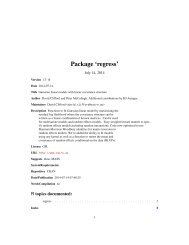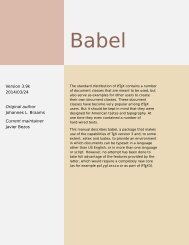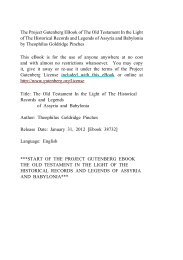- Page 1 and 2: The microtype packageSubliminal ref
- Page 3 and 4: LIST OF TABLES 314.4 Package option
- Page 5 and 6: GETTING STARTED 5these characters a
- Page 7 and 8: OPTIONS: Character protrusion 7Tabl
- Page 9 and 10: OPTIONS: Changing options later 9No
- Page 11 and 12: SELECTING FONTS FOR MICRO-TYPOGRAPH
- Page 13 and 14: MICRO FINE TUNING: Character protru
- Page 15 and 16: MICRO FINE TUNING: Tracking 15stret
- Page 17: MICRO FINE TUNING: Tracking 17Since
- Page 21 and 22: MICRO FINE TUNING: Configuration fi
- Page 23 and 24: LETTERSPACING REVISITED 23\textmicr
- Page 25 and 26: HINTS AND CAVEATS 259 Hints and cav
- Page 27 and 28: HINTS AND CAVEATS 27• With LuaTEX
- Page 29 and 30: SHORT HISTORY 29Additionally, the f
- Page 31 and 32: SHORT HISTORY 31• New option ‘b
- Page 33 and 34: IMPLEMENTATION 3314 ImplementationT
- Page 35 and 36: IMPLEMENTATION: Preliminaries 35\MT
- Page 37 and 38: IMPLEMENTATION: Preliminaries 3714.
- Page 39 and 40: IMPLEMENTATION: Preliminaries 39202
- Page 41 and 42: IMPLEMENTATION: Preliminaries 41\MT
- Page 43 and 44: IMPLEMENTATION: Preliminaries 43\MT
- Page 45 and 46: IMPLEMENTATION: Preliminaries 45\MT
- Page 47 and 48: IMPLEMENTATION: Preliminaries 47\MT
- Page 49 and 50: IMPLEMENTATION: Preliminaries 49\MT
- Page 51 and 52: IMPLEMENTATION: Preliminaries 51765
- Page 53 and 54: IMPLEMENTATION: Preliminaries 53853
- Page 55 and 56: IMPLEMENTATION: Font setup 55\MT@co
- Page 57 and 58: IMPLEMENTATION: Font setup 57\ifMT@
- Page 59 and 60: IMPLEMENTATION: Font setup 591087 \
- Page 61 and 62: IMPLEMENTATION: Font setup 61\MT@sc
- Page 63 and 64: IMPLEMENTATION: Font setup 63\MT@wa
- Page 65 and 66: IMPLEMENTATION: Font setup 65\MT@lo
- Page 67 and 68: IMPLEMENTATION: Font setup 67\MT@ex
- Page 69 and 70:
IMPLEMENTATION: Font setup 69\MT@sp
- Page 71 and 72:
IMPLEMENTATION: Font setup 71\MT@pr
- Page 73 and 74:
IMPLEMENTATION: Font setup 73\MT@se
- Page 75 and 76:
IMPLEMENTATION: Font setup 75\lssty
- Page 77 and 78:
IMPLEMENTATION: Font setup 77\MT@tr
- Page 79 and 80:
IMPLEMENTATION: Font setup 79\MT@tr
- Page 81 and 82:
IMPLEMENTATION: Font setup 81\MT@ls
- Page 83 and 84:
IMPLEMENTATION: Font setup 83\MT@cf
- Page 85 and 86:
IMPLEMENTATION: Font setup 85\MT@ne
- Page 87 and 88:
IMPLEMENTATION: Font setup 87\MT@ge
- Page 89 and 90:
IMPLEMENTATION: Font setup 89\MT@is
- Page 91 and 92:
IMPLEMENTATION: Font setup 91\MT@is
- Page 93 and 94:
IMPLEMENTATION: Font setup 93\MT@wa
- Page 95 and 96:
IMPLEMENTATION: Font setup 95\picku
- Page 97 and 98:
IMPLEMENTATION: Font setup 97\MT@ma
- Page 99 and 100:
IMPLEMENTATION: Configuration 99\MT
- Page 101 and 102:
IMPLEMENTATION: Configuration 101\M
- Page 103 and 104:
IMPLEMENTATION: Configuration 103\M
- Page 105 and 106:
IMPLEMENTATION: Configuration 10531
- Page 107 and 108:
IMPLEMENTATION: Configuration 107\M
- Page 109 and 110:
IMPLEMENTATION: Configuration 109\M
- Page 111 and 112:
IMPLEMENTATION: Configuration 11134
- Page 113 and 114:
IMPLEMENTATION: Configuration 113\M
- Page 115 and 116:
IMPLEMENTATION: Configuration 115\M
- Page 117 and 118:
IMPLEMENTATION: Package options 117
- Page 119 and 120:
IMPLEMENTATION: Package options 119
- Page 121 and 122:
IMPLEMENTATION: Package options 121
- Page 123 and 124:
IMPLEMENTATION: Package options 123
- Page 125 and 126:
IMPLEMENTATION: Package options 125
- Page 127 and 128:
IMPLEMENTATION: Package options 127
- Page 129 and 130:
IMPLEMENTATION: Package options 129
- Page 131 and 132:
IMPLEMENTATION: Package options 131
- Page 133 and 134:
IMPLEMENTATION: Package options 133
- Page 135 and 136:
CONFIGURATION FILES: Font variants
- Page 137 and 138:
CONFIGURATION FILES: Note on admiss
- Page 139 and 140:
CONFIGURATION FILES: Character inhe
- Page 141 and 142:
CONFIGURATION FILES: Character inhe
- Page 143 and 144:
CONFIGURATION FILES: Font expansion
- Page 145 and 146:
CONFIGURATION FILES: Character prot
- Page 147 and 148:
CONFIGURATION FILES: Character prot
- Page 149 and 150:
CONFIGURATION FILES: Character prot
- Page 151 and 152:
CONFIGURATION FILES: Character prot
- Page 153 and 154:
CONFIGURATION FILES: Character prot
- Page 155 and 156:
CONFIGURATION FILES: Character prot
- Page 157 and 158:
CONFIGURATION FILES: Character prot
- Page 159 and 160:
CONFIGURATION FILES: Character prot
- Page 161 and 162:
CONFIGURATION FILES: Character prot
- Page 163 and 164:
CONFIGURATION FILES: Character prot
- Page 165 and 166:
CONFIGURATION FILES: Character prot
- Page 167 and 168:
CONFIGURATION FILES: Character prot
- Page 169 and 170:
CONFIGURATION FILES: Character prot
- Page 171 and 172:
CONFIGURATION FILES: Character prot
- Page 173 and 174:
CONFIGURATION FILES: Character prot
- Page 175 and 176:
CONFIGURATION FILES: Character prot
- Page 177 and 178:
CONFIGURATION FILES: Character prot
- Page 179 and 180:
CONFIGURATION FILES: Character prot
- Page 181 and 182:
CONFIGURATION FILES: Character prot
- Page 183 and 184:
CONFIGURATION FILES: Character prot
- Page 185 and 186:
CONFIGURATION FILES: Interword spac
- Page 187 and 188:
CONFIGURATION FILES: Interword spac
- Page 189 and 190:
CONFIGURATION FILES: Additional ker
- Page 191 and 192:
OPENTYPE CONFIGURATION FILES: Chara
- Page 193 and 194:
OPENTYPE CONFIGURATION FILES: Chara
- Page 195 and 196:
OPENTYPE CONFIGURATION FILES: Chara
- Page 197 and 198:
OPENTYPE CONFIGURATION FILES: Chara
- Page 199 and 200:
OPENTYPE CONFIGURATION FILES: Chara
- Page 201 and 202:
OPENTYPE CONFIGURATION FILES: Chara
- Page 203 and 204:
OPENTYPE CONFIGURATION FILES: Chara
- Page 205 and 206:
OPENTYPE CONFIGURATION FILES: Chara
- Page 207 and 208:
OPENTYPE CONFIGURATION FILES: Chara
- Page 209 and 210:
OPENTYPE CONFIGURATION FILES: Chara
- Page 211 and 212:
AUXILIARY FILE FOR MICRO FINE TUNIN
- Page 213 and 214:
THE TITLE LOGO: Macros 213\printbbs
- Page 215 and 216:
THE TITLE LOGO: Macros 2153. The bo
- Page 217 and 218:
THE LETTERSPACING ILLUSTRATION: Doc
- Page 219 and 220:
THE LETTERSPACING ILLUSTRATION: Mac
- Page 221 and 222:
THE LETTERSPACING ILLUSTRATION: Doc
- Page 223 and 224:
CHANGE HISTORY 2232004/11/26 Versio
- Page 225 and 226:
CHANGE HISTORY 225Protrusion: fix:
- Page 227 and 228:
CHANGE HISTORY 2272007/01/21 Versio
- Page 229 and 230:
CHANGE HISTORY 2292010/01/10 Versio
- Page 231 and 232:
INDEX 231\fontdimen . . . . . . . .
- Page 233 and 234:
INDEX 2331792-1794, 2313, 2768, 277
- Page 235 and 236:
INDEX 235\MT@noresttrue . . . . . .
- Page 237 and 238:
INDEX 2373805, 3807, 3809, 4010, 40
- Page 239 and 240:
THE LATEX PROJECT PUBLIC LICENSE 23
- Page 241:
THE LATEX PROJECT PUBLIC LICENSE 24



